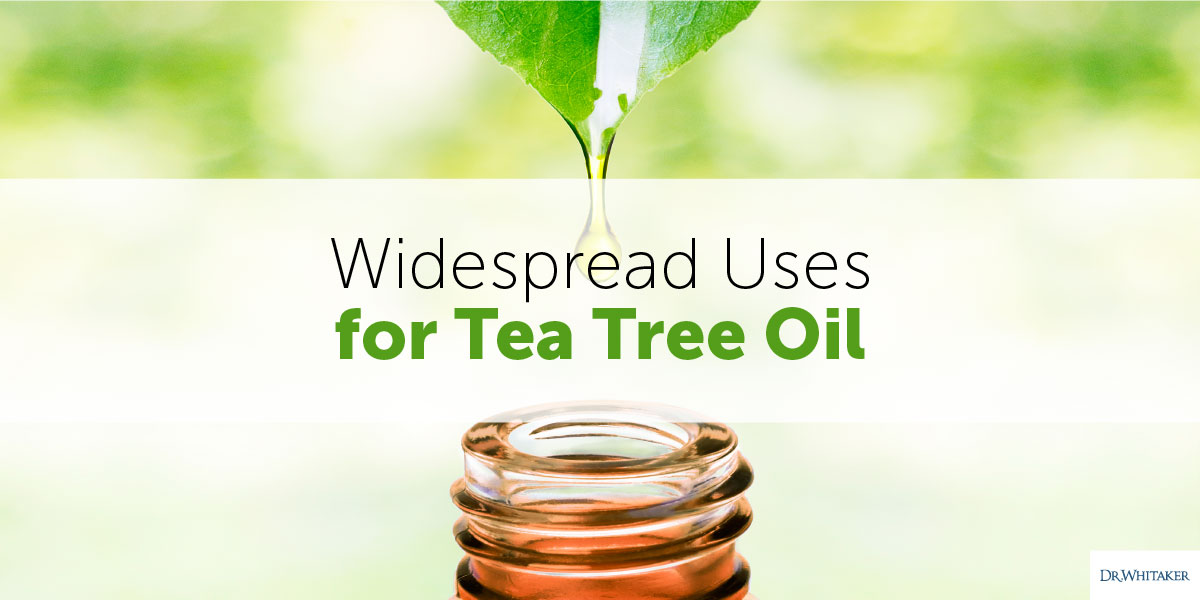
Tea tree oil (Melaleuca alternifolia), which has been used by aboriginal tribes in Australia for centuries, is a popular natural therapy for a wide variety of common concerns. The health benefits of tea tree oil stem mostly from its powerful antimicrobial and antibacterial properties. Let’s take a closer look at the many uses for tea tree oil.
Help Eliminate Nail Fungus
One of the most common uses for tea tree oil is treating fungal infections of the fingernails and toenails (onychomycosis). A double-blind study comparing tea tree oil to clotrimazole, a prescription topical antifungal drug, found the two to be equally effective. In this randomized trial of 117 patients with onychomycosis, six months of therapy with either tea tree oil or the drug resulted in identical treatment repsonse.
I’m not saying tea tree oil is a slam-dunk. Nail fungus is a stubborn condition, but as this study suggests, the natural approach is as effective as topical antifungal drugs—and far safer than oral antifungals. In fact, the FDA has issued a public health advisory about Lamisil and Sporanox, whose side effects include heart failure, severe liver damage, and death. According to The Medical Letter on Drugs and Therapeutics, “The advisability of taking either of these expensive drugs for months to treat an infection that is mainly cosmetic and may relapse is unclear.”
Topical tea tree oil, on the other hand, is safe and nontoxic. To eliminate nail fungus, rub full-strength oil onto the nail twice daily. The key is persistence—it may take eight to 10 months before the infection is eradicated. Tea tree oil benefits can be enhanced by applying DMSO immediately afterward to the same area to enhance penetration. I recommend that you try this simple home remedy before using prescription or over-the-counter antifungal medication.
Eliminate Body Odor...Naturally
A while back, I received this email from a former patient noting a novel use for tea tree oil.
For years, I suffered with the embarrassing problem of body odor. No matter what deodorant or antiperspirant I tried, I still seemed to, well, stink. Then one day, I read about the many health benefits of tea tree oil and decided to see if it could help me. After I showered, I dabbed a little tea tree oil under my arms, waited for it to dry, and then applied my regular deodorant over the top. It worked from day one—even my spouse commented on it. I’d prefer you don’t use my name, but I really hope anyone with problematic body odor gives this a try.
When you sweat, the apocrine glands in the armpits release waste products, fats, and other toxins from the body. When these substances interact with bacteria on your skin, body odor results. Tea tree oil’s demonstrated antibacterial properties likely kill off these bacteria, reducing the unpleasant odor. I imagine it may sting a bit on just-shaved areas, but other than that, it’s worth a shot. If you have allergies or other skin sensitivities, I suggest testing a 5-10 percent tea tree oil solution on a small area 24 hours prior to widespread application, just to be on the safe side.
Alleviate Athlete's Foot and Jock Itch
These common conditions, which plague millions of men, are caused by various types of ringworm fungus, which thrives in moist, warm, dark places. Keeping these areas clean, dry, and aired (as much as decency allows) especially during the warmer summer months, will go a long way toward discouraging the growth of the fungus.
Over-the-counter spray and powder antifungals such as Lotrimin (miconazole nitrate) work pretty well. However, if you prefer a more natural approach to treating athlete’s foot and jock itch, try tea tree oil. This particular health benefit of tea tree oil was so effective that it was adopted by the Australian military during World War II to treat "jungle rot." Tea tree oil should be diluted per product instructions—generally a 5-10 percent solution for the skin—and applied to the affected area with a cotton ball three or four times a day. Continue using it for two weeks after signs of infection subside. Discontinue immediately if irritation occurs.
Even More Uses for Tea Tree Oil
Tea tree oil benefits don't end there. One of my newsletter subscribers got rid of a wart by dipping a Q-Tip in tea tree oil and applying it two to three times a day for three days. Other people have reported that the redness and swelling associated with poison ivy, oak, and sumac can be relieved by dabbing a little tea tree oil on the affected areas. The antimicrobial properties of tea tree oil also make it an excellent topical antiseptic for acne.
This diverse oil can even be used as a household cleaner. To remove mold from ceilings and walls, clean with a mixture of two cups water and two teaspoons of tea tree oil.
As you can see, tea tree oil is an excellent, time-tested remedy that should be a go-to in everyone’s medicine cabinet. It is widely available in health food stores and online.


